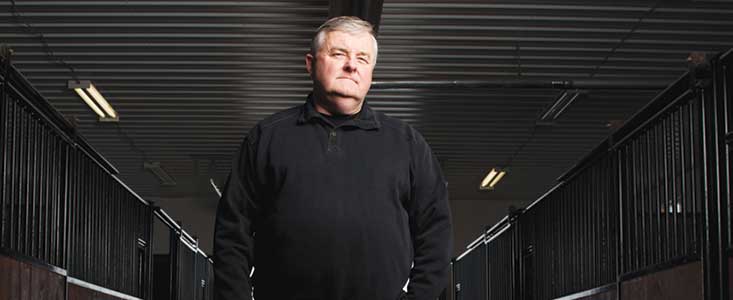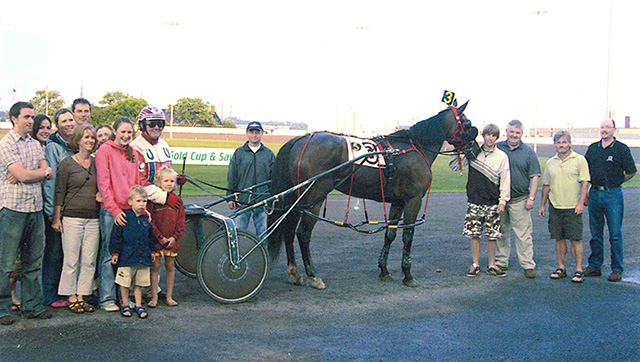Bill Andrew appreciates and respects the past, but the challenge of a new and exciting future for harness racing is what keeps him in the industry.
In both Atlantic Canada and Alberta, Andrew has witnessed highs and lows, but the need to make racing relevant to young people, drives him to continue. By Melissa Keith

William (Bill) Andrew brings an unmistakable sense of perspective to harness racing, earning his place in the Canadian Horse Racing Hall of Fame’s Builder category for his work to support Atlantic and Western Canadian racing. Ask him about where his motivation comes from, and there is no single horse, person, or event that explains it. Like many generations of Maritimers, he was steeped in the sport and its culture from a young age: “I grew up knowing racing and following racing, more as a fan than anything.”
When that culture showed signs of imminent disappearance in Alberta, Andrew saw a disturbing crossroads ahead. “About 12 or 13 years ago, we were involved a little bit, and had just started up with Meridian [Farms] out here [Alberta],” he informs TROT. “We were involved in racing, and were racing in Calgary at the Stampede, and in Edmonton at Northlands, and it looked like we were getting involved in a sport where they were just losing interest.”
On June 15, 2008, Stampede Park officially ended its 120-year relationship with horse racing. Even as a relative newcomer to the Standardbred breeding business, Andrew was not prepared to divest in response to the news.
“I’m reminded of an old neighbourhood or factory, and you see it start getting shuttered up: Something that was once vibrant is now something that isn’t relevant anymore and is slowly fading away,” he says, explaining his observations of the provincial harness racing scene at the time. “The Standardbred industry in particular in Alberta was being left in the wilderness, racing at smaller tracks, not having as much access as we could have with Northlands.”
He could have walked away. Instead, he doubled down. Andrew had been an executive with the Alberta Standardbred Horse Association (ASHA), but he decided to further increase his commitment to racing. “I just said, ‘We’ve got to get going here. And the biggest thing we need is to get involved with the community.’”
Outreach took the form of letting community members and civic leaders know about the good that harness racing brings to its surroundings. “I felt that we had to do it, because at that point, racetracks, particularly the big tracks, were abandoning us,” says the owner of Meridian Farms, which has locations in High River, Alberta and Milton, PEI. “The responsibility fell on ASHA, and on individual people on our side, the racing and the breeding side, to get out there and promote.”
He remembers the stereotypes that plagued the province’s harness racing in those years. Even attempts to build support through philanthropy were sometimes treated with skepticism. “When we reached out, for every two or three [community] groups that said ‘Oh yeah, we’d love to come down and watch the races and we love the idea of having a horse race on behalf of our charity’, we would get some who said, ‘We like the idea of raising money, but we don’t like the idea of doing it at a racetrack.’”
The reasons for rejecting racing stemmed mainly from gambling-related concerns and a lingering, if ill-defined, bad reputation. “We would hear everything! They would say, ‘My dad took me to the races when I was six and there was just a bunch of guys around, smoking cigars…’”
Andrew, a petroleum industry engineer and past CEO of oil and gas companies, knows about the need for public support in any business. “You have to be a good corporate citizen, or you’ll just get abandoned,” he advises. “Certainly, working at public companies and running them, you have to make the public aware that there are shares of your company available and maintain a shareholder base. A lot of it is just the product itself, so how is the product we’ve got performing at the racetrack? But another part of it is, getting out and talking with investors who may not own your stock. You know: ‘This is a stock that you should own and here are the reasons why.’
“The other thing I really realized in running public companies is that you have to have a social contract as well.”

Trying to regain a dwindling fan base, at a moment when live racing venues were looking increasingly scarce, required well-placed supporters and people who cared about Alberta harness racing’s future. Andrew says he was blindsided by what he discovered: “The realization, as things started to crumble away, that we had no friends. We didn’t particularly have any enemies, but we didn’t have any people who were actively involved in racing. We had hardcore fans, we certainly had owners and breeders who were actively participating in the industry, but those numbers were going down. There was no community awareness of racing.”
Horses bred or owned by Andrew are sometimes named after Maritime racing stars of decades past, acknowledging the Andrew family’s enduring love of the game. Exit Smiling, a pacer who won at Century Downs on May 20, sports the same name as James “Roach” MacGregor’s top trotting mare, a foal of 1975 (2:02.4f; $58,796).
Bill’s brother, Brian, operates Meridian’s PEI facility out of what was once Glengyle Farm, formerly owned by the late MacGregor. Their father, Erwin Andrew, served in World War II, and afterward with the Royal Canadian Air Force, keeping his hand in racing for the joy of it. Grandfather Blair Andrew was the top dash-winning driver at Saint John, New Brunswick’s Exhibition Park Raceway in 1954.
And even though he appreciates and respects the past, Bill Andrew is future-oriented in his thinking, balancing an appreciation for those memories with the pressing need to make racing relevant to younger audiences. “You can’t just say, ‘Here it is, and we’re going to run it the exact same way we did in 1956’. It doesn’t work that way anymore.”
He notes that it’s not handle that will determine whether harness racing continues in a given region, but the presence of happy children on the trackside apron. “When I’m watching the kids watching the horses, watching the outriders, and they’re running around, it reminds me of when I was six or seven or eight, and would go to the racetrack and run around,” he chuckles. “We also knew what was going on -- we knew who the drivers were, who we’d cheer for, but the first thing was to have someone take us there, to see it.”
Positioning harness racing as entertainment meant breaking away from the notion that a day at the track meant one thing: gambling on races. Outreach by Alberta harness racing participants has helped build a new audience that cares, and charitable activities at provincial tracks are winning the battle for positive public perception. “I compare it to: If the local community arena is falling down and nobody cares, then there will be no place for your kids to play hockey,” says Andrew. “Yeah, you can stay home and watch the NHL, but that does precious little with the community.”
At its crossroads, Alberta harness racing found a home in an unusual place where it has stayed popular since its reintroduction. “In Lacombe, before we went out there to race, the last time they had racing there was in the ‘50s,” remarks Andrew, discussing the important role played by Alberta Downs. The picturesque track hosted its first modern season of harness racing in 2009, the result of collaboration among ASHA, Alberta Downs, Horse Racing Alberta, and the Rocky Mountain Turf Club. Located in a community of roughly 11,000 people, hours from Stampede Park and Northlands Park, the setting was a pleasant, if not permanent, solution to racing’s woes.
“I don’t think any of the owners or anyone on the backstretch said ‘This is the way it’s going to be forever’,” he recalls. “All of us knew that an effort was being made. We always hung on by our fingernails at Northlands. We knew we had to keep the metro exposure up, and we were working on a new racetrack and casino concept in Calgary.”
With Century Downs and Casino in Balzac celebrating its third birthday this year, and Century Mile slated to take over race dates in Edmonton, it might seem that Andrew could finally relax. But he tells TROT that harness racing, like live music and other sports, must be constantly promoted in order to stand out as a valid entertainment option. It’s nonetheless on much more stable footing than it was in Meridian West’s early years, leaving him with little spare time. So what else has the 2018 Hall of Fame inductee been up to?
“I’m crazy enough that I started getting involved with junior hockey in Calgary, which has got the same challenges now that horse racing did 10 years ago,” he shares. “With the saturation of the NHL product, if you go to the small rinks, it’s challenging to get fans out.”


